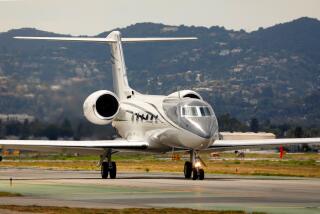Space Travel Price No Longer Out of This World
- Share via
If floating weightless and peering down on a shimmering-blue Earth sounds appealing, you might consider being a space tourist.
As long as you’ve got a fat wallet.
Two years after the first privately financed space flight jump-started a sleepy industry, more than a dozen companies are developing rocket planes to ferry ordinary rich people out of the atmosphere.
Several private companies will begin building their prototype vehicles this summer with plans to test fly them as early as next year. If all goes well, the first tourist could hitch a galactic joy ride late next year or 2008 -- pending approval by federal regulators.
Unlike the Cold War space race between the United States and Soviet Union that sent satellites into orbit and astronauts to the moon, this competition is bankrolled by entrepreneurs whose competition could one day make a blast into space cheap enough for the average Joe.
“This time, it’s personal. This space race is about getting ‘us’ into space,” space historian Andrew Chaikin said.
For now, commercial space travel remains an exclusive club.
Over the last few years, three tourists have paid a reported $20 million each to ride aboard a Russian rocket to the orbiting international space station.
The three spent about a week weightless and described the experience as “paradise” and “wondrous.”
Prospective prices for the next round of personal space flights aren’t so astronomical -- a seat aboard one of the yet-to-be-built commercial spaceships will fetch $100,000 to $250,000. Space entrepreneurs expect the price tag to drop once the market matures.
Tourists will get what they pay for.
Instead of days in space, the commercial spaceships under development will reach only suborbital space, a region about 60 miles up that is generally considered the beginning of the rest of the universe. Because the private spaceships lack the speed to go into orbit around Earth, the flights are essentially up and down experiences -- lasting about two hours with up to five minutes of weightlessness.
It’s more of a ride than those offered by several companies that use Boeing 727s to produce a half-minute of weightlessness through a series of maneuvers about 25,000 feet up. Those flights, which generally sell for about $3,000, never reach space.
Here is a rundown of several companies that will start building their private spaceships this summer:
* The biggest name is Virgin Galactic, a space tourism firm founded by British billionaire Richard Branson. Branson has partnered with Burt Rutan, whose SpaceShipOne in 2004 became the first private manned craft to reach space, to build a fleet of suborbital commercial spaceships called SpaceShipTwo.
SpaceShipTwo is about the size of a corporate Gulfstream jet that can hold six tourists and two crew members. Like SpaceShipOne, it will be powered by a hybrid rocket motor and use a “feathering” technique to glide back to Earth.
The design of SpaceShipTwo is complete and construction is slated for this summer with test flights scheduled for late next year. The project’s $100-million first phase is financed by Branson’s Virgin Group, Virgin Galactic President Will Whitehorn said.
* Oklahoma-based Rocketplane Kistler is one of Virgin Galactic’s biggest competitors. Rocketplane Kistler, whose main investor is American businessman George French, hopes to start test flights in January and fly commercially by summer 2007.
The company is building a souped-up, 42-foot-long suborbital Lear jet that can seat three passengers and a pilot. Unlike SpaceShipTwo, which would piggyback atop a mother ship to a certain altitude, the Rocketplane XP would take off and land like an airplane using turbojets and rockets.
* Space Adventures, a Virginia-based space travel agency best known for brokering three tourists to the international space station, is the latest entrant.
Last month, Space Adventures announced a partnership with members of the Ansari family -- the major funders of the $10-million X Prize won by SpaceShipOne -- to develop Russian-designed suborbital rockets that would launch from a proposed spaceport in the United Arab Emirates by 2008.
Space tourism companies hope wary investors will provide financial backing once they can establish a safety record and prove there is sufficient demand.
“It’s changed from being a giggle factor to being heralded as a new business,” said Geoff Sheerin, president and chief executive of Canada-based PlanetSpace.
* PlanetSpace, backed by American businessman Chirinjeev Kathuria, is building a 54-foot-long, three-seat suborbital rocket that would launch from somewhere in the Great Lakes region and reenter Earth by splashing into the water.
Futron, a Bethesda, Md.-based aerospace consulting firm, estimated that revenues in the space tourism industry could exceed $1 billion a year by 2021 with the greatest demand in suborbital flights in which passengers spend mere minutes in space.
Before tourists can lift off, several federal hurdles must be cleared. Federal regulations that will govern human space travel and spell out safety and training requirements are expected to be wrapped up this summer.
More to Read
Sign up for The Wild
We’ll help you find the best places to hike, bike and run, as well as the perfect silent spots for meditation and yoga.
You may occasionally receive promotional content from the Los Angeles Times.






